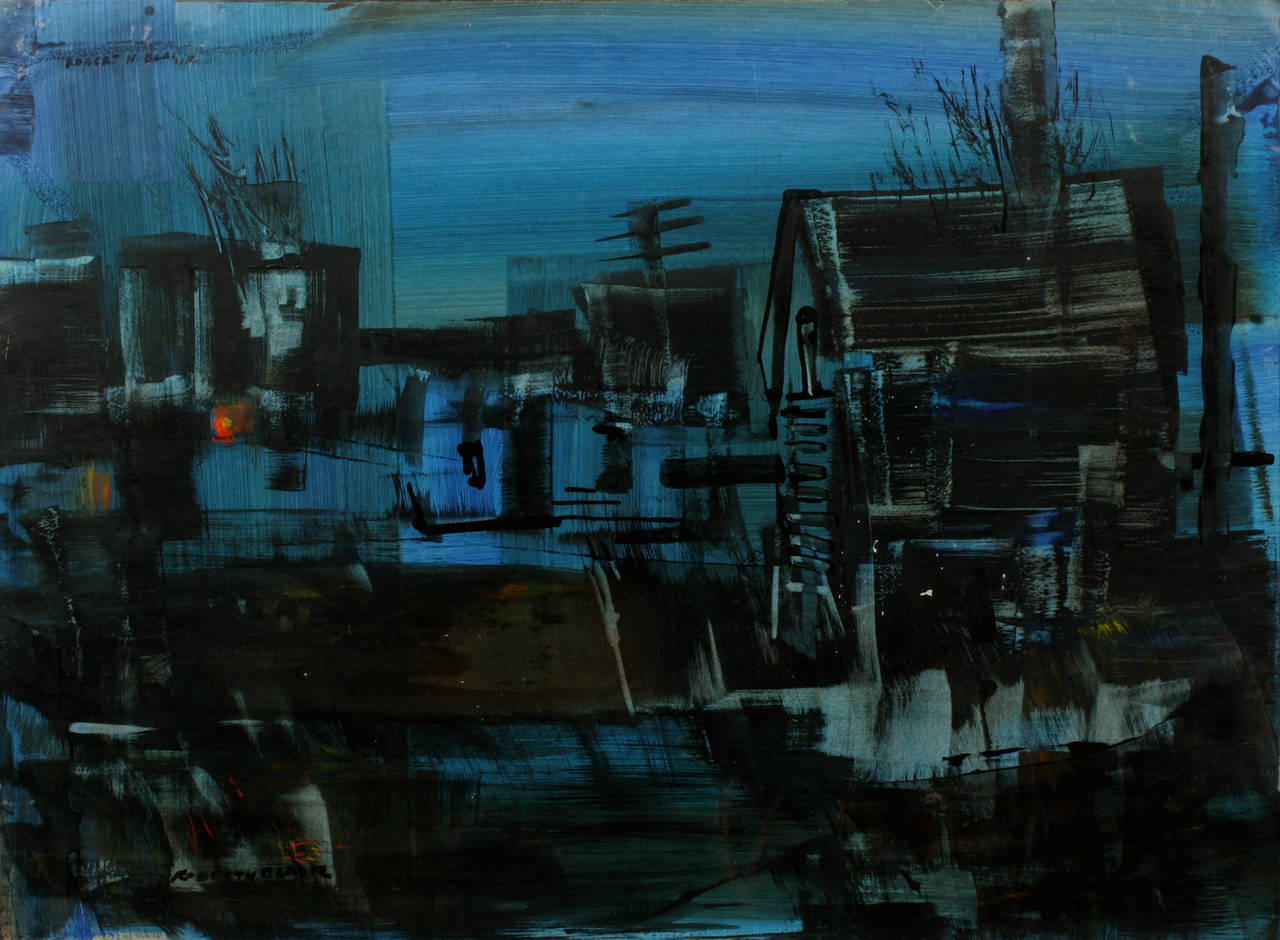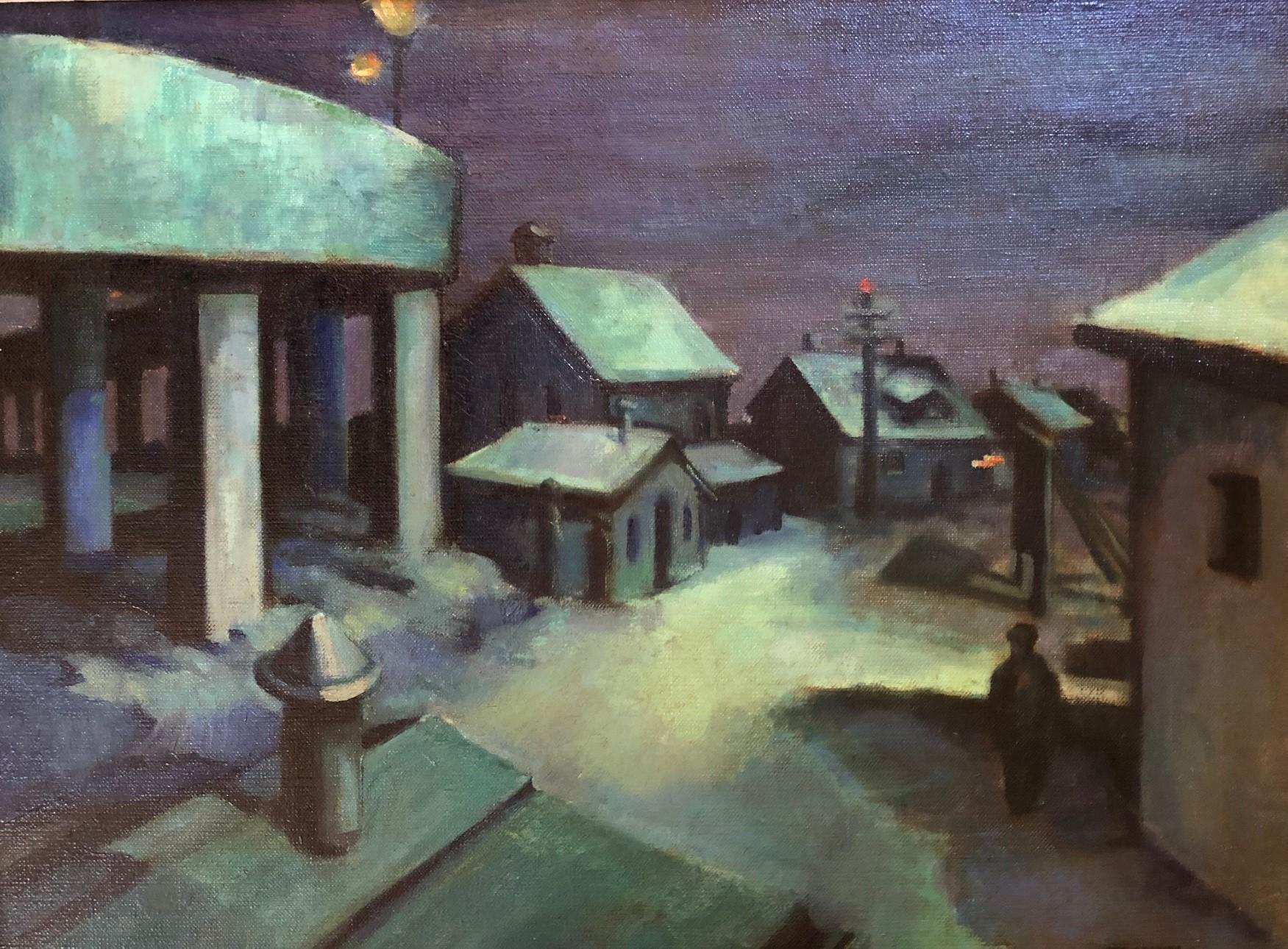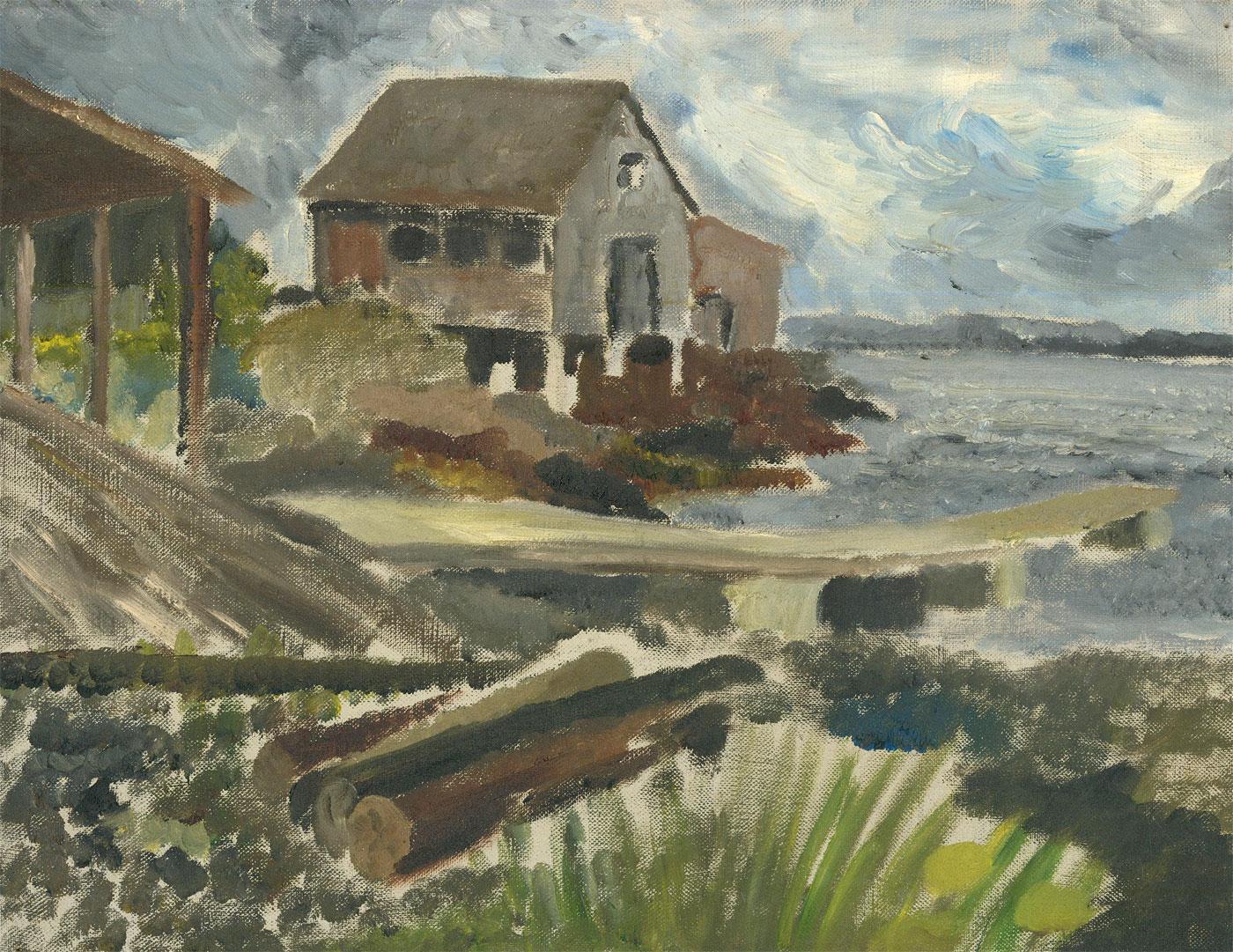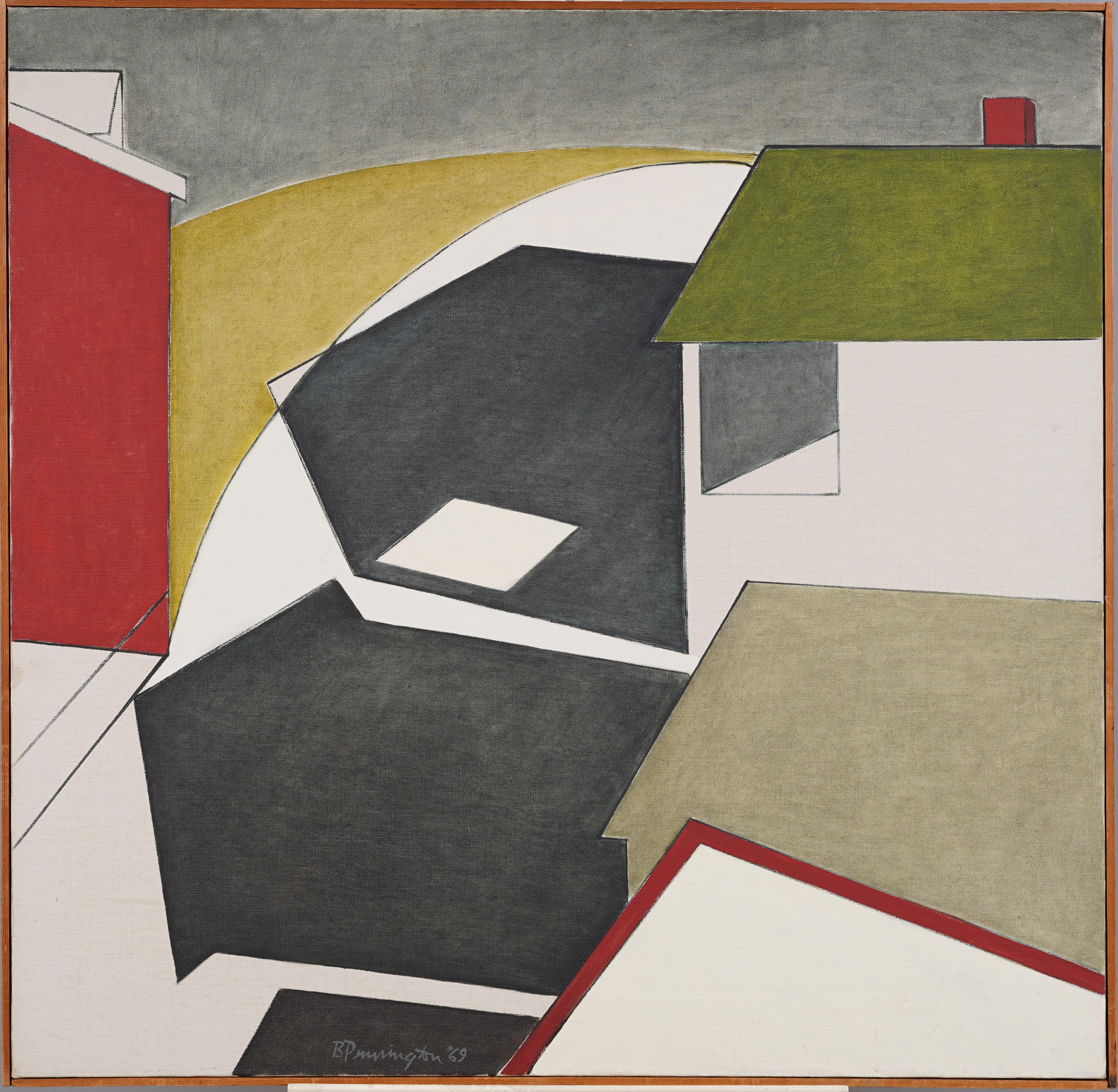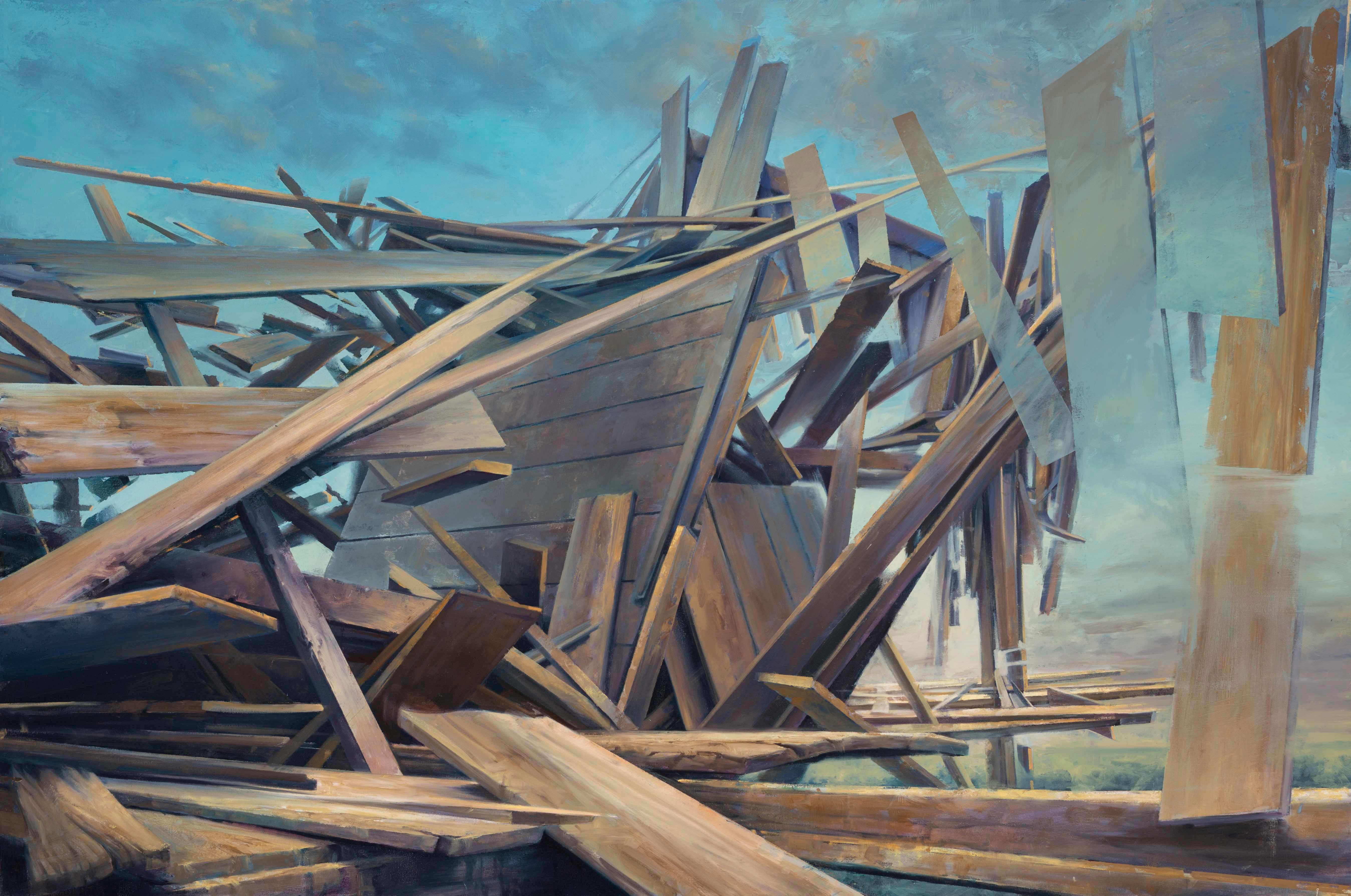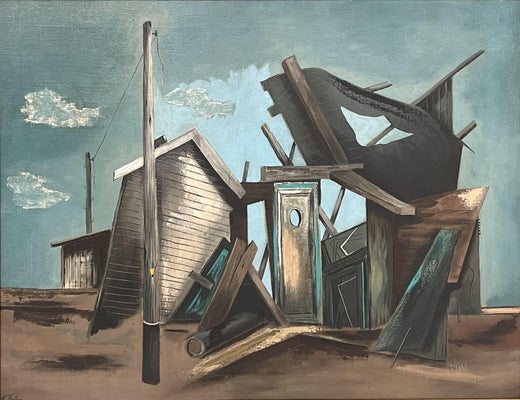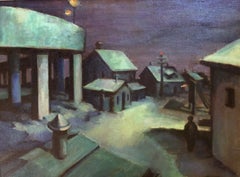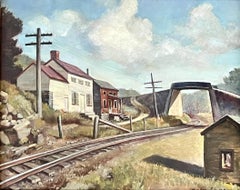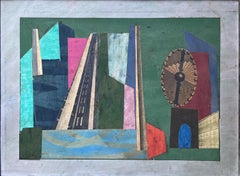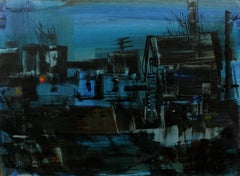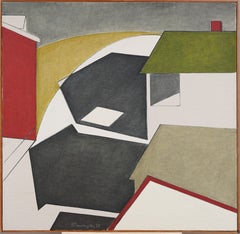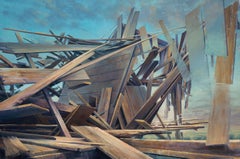Items Similar to Untitled (Collapsed Shacks)
Want more images or videos?
Request additional images or videos from the seller
1 of 6
Karl FortressUntitled (Collapsed Shacks)c. 1940s
c. 1940s
$6,500
£5,060.69
€5,755.46
CA$9,350.06
A$10,272.70
CHF 5,368.58
MX$122,510.47
NOK 67,980.71
SEK 63,329.76
DKK 43,007.48
About the Item
Untitled (Collapsed Shacks), c. 1940s, oil on canvas, signed lower left, 20 ½ x 26 ½ inches, presented in a period frame
This work is part of our exhibition America Coast to Coast: Artists of the 1940s.
Untitled (Collapsed Shacks) is typical of Karl Fortess' exploration of depopulated Magic Realist scenes of abandoned structures in a state of decay, likely reflecting the uncertainty and angst of the 1930s and 1940s. He often portrayed an unstable world on the verge of disintegration. Fortess was born in Belgium but moved to the United States where he studied at the Art Institute of Chicago, the Art Students League and the Woodstock School of painting under Yasuo Kuniyoshi. Fortess is associated with the Woodstock School artists and was a member of the Woodstock Art Association. During the Great Depression, he worked in WPA art projects. From the early 1930s through the 1950s, Fortess exhibited nationally at the Museum of Modern Art, the Whitney Museum of Art, the Metropolitan Museum, the Woodstock Art Association, the Boston Art Museum, the Corcoran Gallery, the Salons of America, and the Carnegie Institute. In 1946, he won a Guggenheim Fellowship and the Childe Hassam Fund purchase award in 1952. In addition to his fine art practice, Fortess taught at the Art Students League, Brooklyn Museum Art School, Louisiana State University and Boston University’s School of Fine and Applied Arts. He is listed in Who was Who in American Art and all other standard references. His artwok is in the permanent collections of many United States Museums, including the Smithsonian American Art Museum, the National Gallery of Art and the Brooklyn Museum.
- Creator:Karl Fortress (1907 - 1993, American)
- Creation Year:c. 1940s
- Dimensions:Height: 20.5 in (52.07 cm)Width: 26.5 in (67.31 cm)Depth: 2 in (5.08 cm)
- More Editions & Sizes:20.5 x 26.5 inchesPrice: $6,500
- Medium:
- Movement & Style:
- Period:
- Condition:
- Gallery Location:Los Angeles, CA
- Reference Number:1stDibs: LU1859214251032
Karl Fortress
Karl Fortress was a painter, printmaker and teacher. He was born in Antwerp, Belgium on October 13, 1907, and became an American citizen in 1923. He studied at the Art Institute of Chicago, the Art Students League of New York, and the Woodstock School of Art with Yasuo Kuniyoshi. Fortress taught at the Art Students League of New York, Brooklyn Museum Art School, Louisiana State University, Fort Wright College and Boston University College of Fine Arts. Karl Eugene Fortess died in Woodstock, New York on July 8, 1993.
About the Seller
5.0
Gold Seller
Premium sellers maintaining a 4.3+ rating and 24-hour response times
1stDibs seller since 2022
17 sales on 1stDibs
- ShippingRetrieving quote...Shipping from: Los Angeles, CA
- Return Policy
More From This Seller
View AllHighway Derelict
Located in Los Angeles, CA
Highway Derelict, May, 1939, oil on canvas board, signed upper right, 18 x 20 inches, exhibited 1) Society of Independent Artists, American Society of Fine Arts (Art Students League), New York, NY, April 19 – May 12, 1940, no. 535 (noted verso, listed in catalog, and see Kantner, Dorothy, Palette Palaver, Pittsburgh Sun Telegraph, April 19, 1940 – “Helen F. Price and Ethel M. Dean, the former of Johnstown, the latter of this city, are two members of the Associated Artists of Pittsburgh who are represented in the Independent Artist’s Exhibition which opens today in New York. Miss Price is represented by . . . ‘Highway Derelict’ . . . .”), 2) Solo Exhibition of Log Cabin Paintings...
Category
1930s American Modern Landscape Paintings
Materials
Canvas, Oil, Board
Moonlight Shanties
Located in Los Angeles, CA
Moonlight Shanties, c. 1940s, oil on canvas, 24 x 18 inches, signed lower right, signed and titled verso
About the Painting
In Moonlight Shanties, Joachim depicts a lower-class neighborhood sitting along-side an elevated road or railway which crowds out the small nearby houses and structures. Joachim’s use of an expressionist palette and gestural brushstrokes together with the isolated figures obscured in the shadows, create a feeling of unease, isolation and even loneliness. From the 1920s through 1940s, American artists commonly employed expressionist conventions in their social realist works which portrayed the gritty side of urban America, especially the communities of the city-dwelling poor. Expressionist styles were considered appropriate for bridging the gap between the modernist idea of art-for-art’s-sake and the narrative qualities demanded by the dual crises of the Great Depression and World War II. Moonlight Shanties successfully uses these expressionist methods to portray a neighborhood and its people who appear to be literally and figuratively “on the edge.”
About the Artist
Paul Lamar Joachim...
Category
1940s American Modern Landscape Paintings
Materials
Oil
Untitled (Houses and Railroad Tracks)
By Harry Lane
Located in Los Angeles, CA
Untitled (Houses and Railroad Tracks), c. 1940s, oil on canvas board, signed lower right, 16 x 20 inches, presented in a newer frame
This work is part of our exhibition America Coas...
Category
1940s American Modern Paintings
Materials
Oil, Board
Cityscape (Untitled)
Located in Los Angeles, CA
Cityscape (Untitled), c. 1950s, mixed media on board, signed lower left, 13 1/2 x 18 inches, presented in its original frame
Jean (Yanko) Varda was a Greek-born multi-media artist ...
Category
1950s American Modern Mixed Media
Materials
Paper, Oil, Photographic Paper, Board, Magazine Paper
Peck Slip
Located in Los Angeles, CA
Peck Slip, 1950, oil on cardboard, 15 x 20 inches, exhibition label verso reads: “Oil on cardboard, 20 x 15, 1950 / Title: Peck Slip / Price: $100 / Artist and Owner: Fiske Boyd / 30...
Category
1950s American Modern Landscape Paintings
Materials
Oil, Board
Atilt
Located in Los Angeles, CA
Atilt, 1982, acrylic on canvas, 32 x 48 inches, signed and dated lower right, “Alfred P. Maurice 2725 A South Michigan Ave, Chicago, IL, 60616” inscribed verso, “ATILT” inscribed verso, “Maurice.018” inscribed on frame, exhibited: 1) Alfred P. Maurice Artist in the City Paintings 1979 - 1997, Archer Gallery of Clark College, Vancouver, WA, April 8 – April 30, 1997, #11, and 2) An Artful Life: Celebrating the Life of Creator, Teacher, and Collector Alfred Maurice...
Category
1980s American Modern Landscape Paintings
Materials
Canvas, Acrylic
You May Also Like
Shanty Town
By Robert Noel Blair
Located in Buffalo, NY
You are viewing a modernist American acrylic painting depicting a charming but rundown seaside town at night.
Robert Noel Blair (American, 1912-2003) was an American artist, paint...
Category
1950s American Modern Landscape Paintings
Materials
Acrylic, Archival Paper
20th Century Oil - Barns by a Lake
Located in Corsham, GB
An emotive, impressionistic oil of a cold and blustery lake scene, with sheltered buildings and timber logs in the foreground. Unsigned. On canvas on stretchers.
Category
21st Century and Contemporary Landscape Paintings
Materials
Oil
$327 Sale Price
20% Off
Antique American Modernist Abstract Houses Architecture Precisionist NY Painting
Located in Buffalo, NY
Oil on canvas. Framed. Signed.
Category
1940s Modern Abstract Paintings
Materials
Canvas, Oil
$1,020 Sale Price
20% Off
"Cabin 7, " Oil Painting
By Gregory Block
Located in Denver, CO
Gregory Block's (US based) "Cabin 7" is an original, handmade oil painting that depicts a deteriorating cabin wall melding with a sky.
Gregory was born in Kansas City, Missouri, in...
Category
2010s Surrealist Abstract Paintings
Materials
Oil
Buffalo New York Regionalist Modern Landscape Signed Exhibited Rare Oil Painting
Located in Buffalo, NY
Antique American modernist landscape painting signed "Welch '42". Oil on board, circa 1942. Signed. Image size, 16L x 14H. Housed in a modern frame.
Category
1940s Modern Landscape Paintings
Materials
Canvas, Oil
$1,036 Sale Price
20% Off
Leslie Coldrick - 2007 Oil, The Shack
Located in Corsham, GB
A fine contemporary oil scene showing a metal shack with machinery outside. The artist has initialed to the lower right corner and the painting has been presented in a distressed eff...
Category
21st Century and Contemporary Landscape Paintings
Materials
Oil
$305 Sale Price
20% Off
More Ways To Browse
Wpa Art
Woodstock Painting
Oil On Canvas By Edward
Large Black Painting
Large Vintage Canvas Art
Portrait Of A Lady
Puerto Rico
French Blue Painting
Lake Landscape Paintings
Village Oil Painting
Still Life With Fruits Painting
Antique Unframed Canvas Paintings
Jewish Museum
Flower Vase Oil On Canvas
French Floral Still Life Painting
Heart Painting
Layered Art
Art Medal
